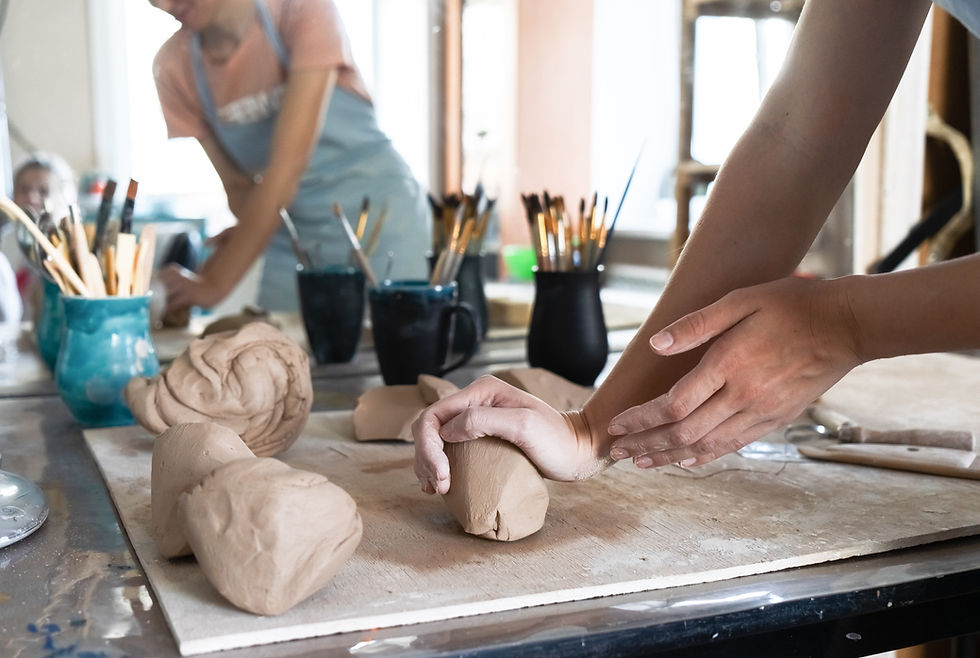Air-Dry Clay vs. Pottery: What Are the Differences and What to Expect?
- Jana Frost
- Jul 6, 2023
- 3 min read
Updated: Jan 22

When exploring the world of clay crafting, one common question arises: should you work with air-dry clay or traditional pottery clay? Both options offer unique benefits, but they cater to different skill levels, tools, and crafting goals. In this article, we’ll explore the differences between these two mediums and outline what you can expect when working with air-dry clay compared to pottery.
What Is Air-Dry Clay?
Air-dry clay is a versatile, lightweight crafting material that hardens naturally at room temperature without requiring a kiln or oven. It’s an ideal choice for beginners, hobbyists, or anyone seeking an accessible and convenient way to create clay objects at home.
Key Features of Air-Dry Clay:
Requires no special equipment, just time to dry.
Easy to sculpt, reshape, and add details.
Works well for small projects, home decor, and art pieces.
Available in a variety of formulas, including lightweight and durable options.
What Is Pottery Clay?
Pottery clay, also called ceramic or kiln-fired clay, is a traditional material used to create everything from functional tableware to intricate sculptures. This type of clay must be fired in a kiln at high temperatures to solidify and make it durable.
Key Features of Pottery Clay:
Requires firing at high temperatures (1,000°C or more).
Often used to create functional items like mugs, bowls, or tiles.
Allows for glazing to make pieces waterproof and shiny.
Ideal for advanced artisans or professionals with access to specialized equipment.
How Do They Differ?
1. Drying Process
Air-Dry Clay: Hardens naturally when left out at room temperature. Pieces must be allowed to fully dry (up to 72 hours depending on thickness).
Pottery Clay: Needs a kiln to undergo the firing process, which turns it into ceramic. This involves two steps: bisque firing and glaze firing.
2. Tools Required
Air-Dry Clay: Minimal tools are needed, making it ideal for at-home crafting. You can use household items like toothpicks, rolling pins, or kitchen tools for sculpting.
Pottery Clay: Requires specialized tools such as a pottery wheel, kiln, and carving tools. Glazing also requires specific equipment.
3. Durability and Water Resistance
Air-Dry Clay: Not inherently waterproof and requires sealing if you plan to use the item near water. Even with sealant, prolonged moisture exposure may damage the piece.
Pottery Clay: Once fired and glazed, it becomes highly durable and completely waterproof, making it ideal for functional items.
4. Artistic Styles and Applications
Air-Dry Clay: Suitable for creative and decorative projects like sculptures, figurines, or home decor. It is lightweight and perfect for modern minimalist designs.
Pottery Clay: Used for traditional ceramic ware or artistic pottery. The fired results feel more polished and robust.
5. Cost and Accessibility
Air-Dry Clay: Affordable, and you don’t need expensive tools or firing facilities. This makes it a great starting point for beginners.
Pottery Clay: More costly due to the need for kilns, glazes, and other specialized equipment. It’s a larger time and financial investment.
What to Expect from Air-Dry Clay
Air-dry clay offers a unique crafting experience distinct from pottery. Here’s what you can look forward to:
Ease of Use: It’s soft, malleable, and ready to use right out of the packaging.
Beginner-Friendly: Perfect for exploring sculpting techniques without a steep learning curve.
Accessibility: You can work with air-dry clay anytime, anywhere—no kiln or workshop required.
Creative Possibilities: From intricate sculptures to customized decor pieces, air-dry clay offers endless artistic options.
However, it’s important to manage expectations: air-dry clay isn’t as strong as fired pottery and is better suited for decorative pieces rather than functional items like mugs or plates.
Who Should Choose Air-Dry Clay?
If you’re a beginner, a casual hobbyist, or working with limited space or resources, air-dry clay is an excellent choice. It allows you to dive into crafting without the need for a steep investment.
Air-dry clay is also a great option for group workshops, art therapy, and one-time projects. Its forgiving nature lets you focus on creativity and mindfulness rather than technicalities.
Who Should Choose Pottery Clay?
Pottery clay is ideal for experienced artisans looking to create functional, durable, and intricate ceramic items. If you’re serious about pottery and have access to a kiln, this option unlocks greater possibilities like glazing, firing, and experimenting with textures and finishes.
Conclusion: Air-Dry Clay or Pottery?
Both air-dry clay and pottery clay bring something special to the table. Your choice depends on your goals, experience level, and access to equipment.
For modern crafting that’s approachable and satisfying, air-dry clay is the ultimate winner. It allows you to enjoy the creative journey without the need for complex tools or firing.
Explore the potential of air-dry clay in one of our mindful clay workshops—whether you're a beginner or an experienced artisan, there's no better way to unleash your creativity!






Comentários